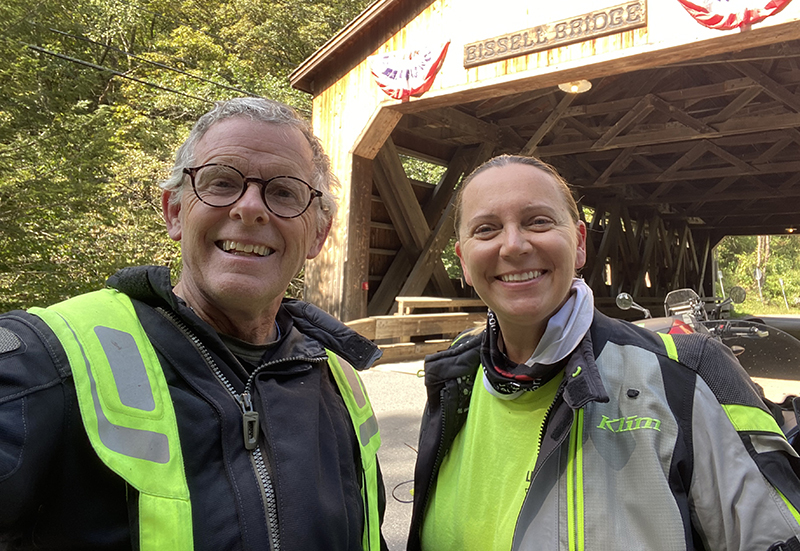Experienced Rider Training with Ken
You don’t need to live in New England to know who Ken Condon is. Besides being a track school instructor who mentored his daughter to become one; he is a road racer, former Motorcycle Safety Foundation (MSF) RiderCoach, columnist for national motorcycle magazines, and author Riding in the Zone, and Motorcycling the Right Way. Ken has been teaching motorcycling skills for decades to help riders become safer and more proficient.
Ken’s Riding in the Zone website contains articles, videos, and podcasts focused on staying safe on two wheels. Additionally, you can find information about training classes. Riders with at least 2,000 to 3,000 miles of experience will find training options such as track days, parking lot classes, street skills, and ADV skills. Want to create an all-ladies class? Talk to Ken about it. He’d love to put one together for your women’s riding group.
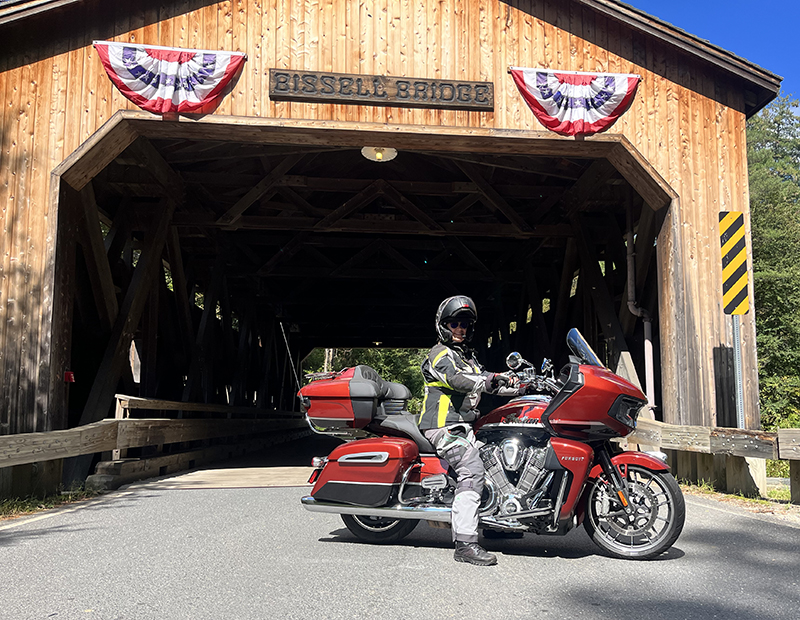
Soon after picking up the Indian Pursuit Premium Icon the company loaned me to test, Ken invited me to a group street riding session in northern Massachusetts. What better way to get to know a new-to-me bike and work on my skills? Ken limits the number of participants to 3-4 riders and uses Sena communication systems for real-time feedback. So I charged my Schuberth C5 (which incorporates a Sena-based comm system) and headed north for a great day of riding and learning.
Getting in the Zone
The day begins with a briefing where Ken discusses the basics with the aid of a slide show. He learns how much we know so that he can tailor the instruction to each student. For example, he asks, “Describe how you use your brakes.” I could tell from our group of four that we were all skilled riders, because all of us use braking techniques beyond the MSF Basic RiderCourse (BRC) recommendation (to use both brakes all the time.)
Braking techniques are discussed, including trail braking and how it loads the suspension. Ken keeps it as simple as possible, making it easy to understand for those of us who aren't physics majors.
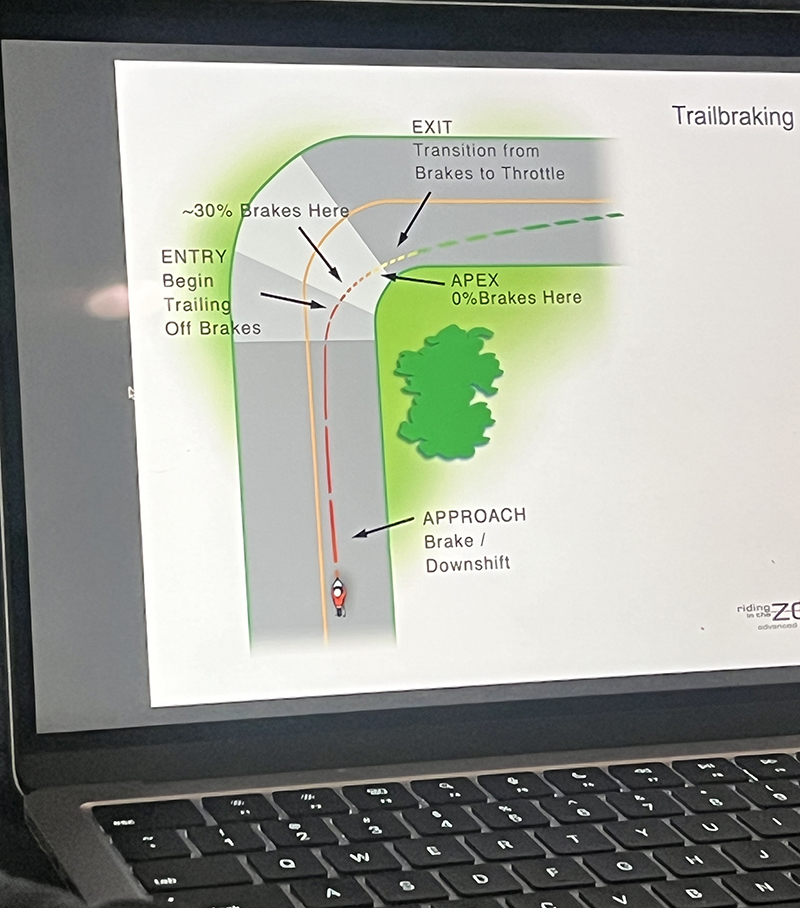
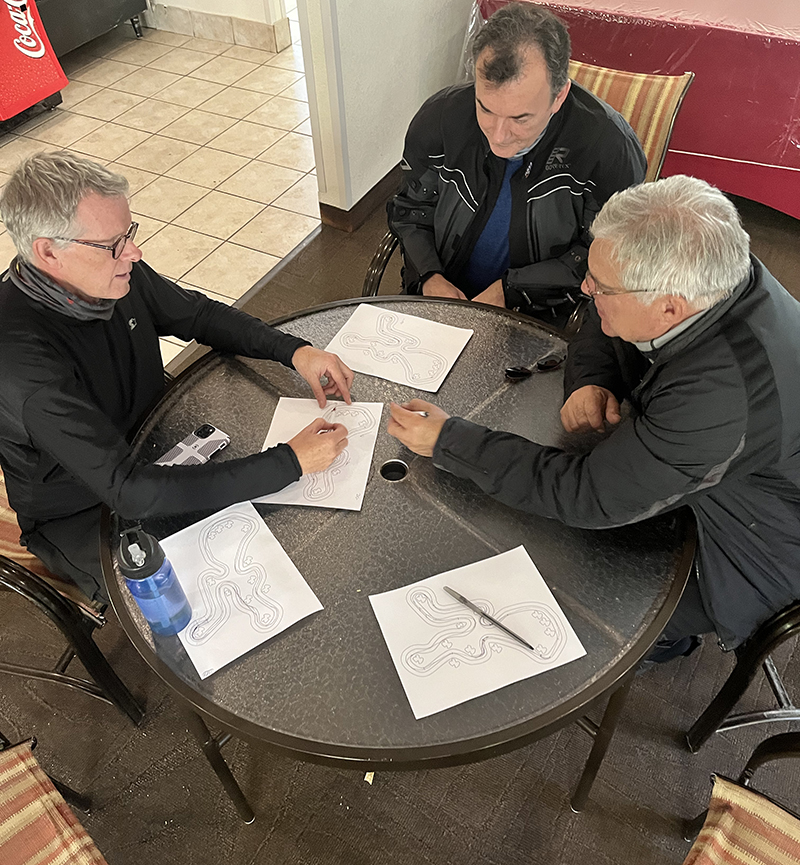
Slow Speed Control
The group starts out practicing closed course drills on a well-paved parking lot before heading out. Riding in the Zone street training includes slow-speed drills like u-turns, slow speed control, and basic quick stops.
As a RiderCoach myself, I regularly practice these things. But I’m not fully confident doing u-turns on the large Indian Pursuit. I humbled myself early on when I lost momentum and dropped the big tourer. Ken asks, “So, what went wrong?” Instead of telling me what he believes happened, he made me think about what went wrong. It’s a learning method that works well for me; reflecting rather than being told. In this case, giving the Indian more throttle and staying on it while working the clutch a bit more is the trick.
We also practice a bit of trail braking in the parking lot while Ken watches and coaches through the Sena Bluetooth headsets. It is a great time to watch each rider and learn from our collective strengths and weaknesses.
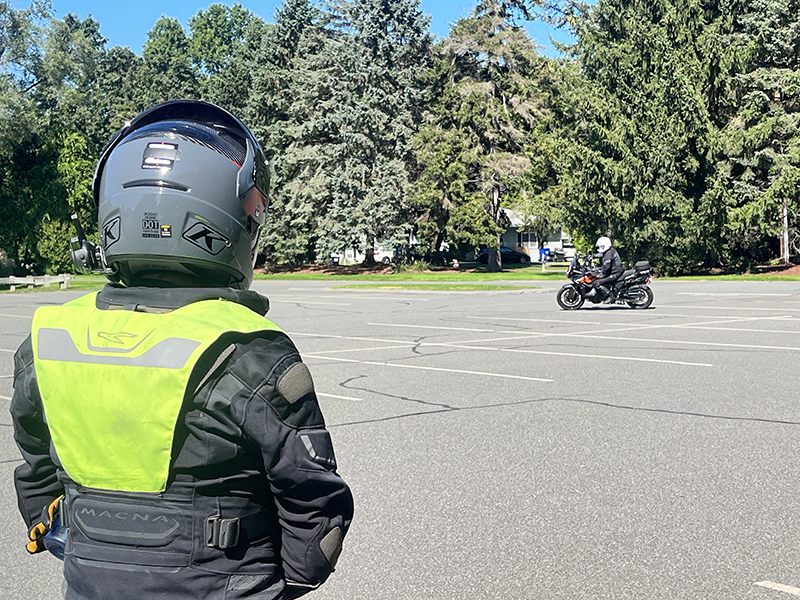
Once Ken sees that none of us need additional practice, we move on. Unlike the strict MSF curriculum, Riding in the Zone training doesn’t require pre-determined times to stick to a specific exercise. Ken tailors the training to what the riders need which keeps us fully engaged.
Riding in the Zone, On the Road
The rest of the day includes about 120 miles of road training through the northern Berkshires of Massachusetts and the Southern Green Mountains of Vermont. As a resident of the area, Ken knows the roads well and adjust the route on the fly to better suit students.
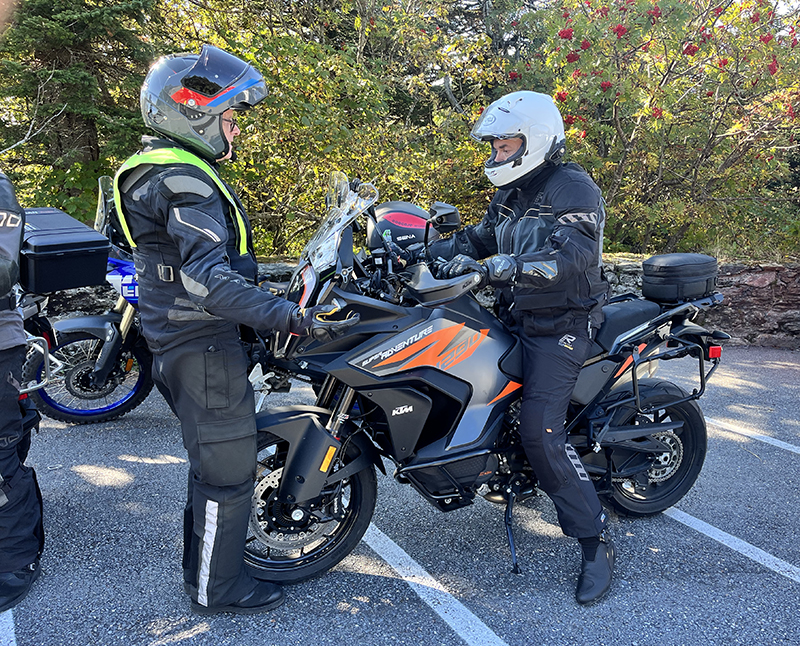
Riding in the Zone students are instructed to listen rather than create noisy chatter that may impede learning opportunities. I love how Ken narrates the ride, explaining the visual targets we should look for that help us “see” farther through turns. He not only demonstrates lane positioning, but also verbalizes it, choosing his words carefully. He seems mindful of repeating what is important without becoming monotonous.
He also does this when explaining how and when we should be using our brakes and throttle to corner more efficiently. We all take turns leading while he looks on, giving tips and pointers along the way. He keeps our speed near the posted limit because this training is not about going faster. It’s about becoming a more skilled rider. And when you are a better rider, the speed comes naturally.
Ken uses a leap-frog, single line formation. One rider leads for a bit, then moves right and waits for the line to pass to ride in the back. Everyone gets ample time for critique and coaching.
Emergency Braking
We also work on high speed braking which is more brow raising than the quick stops I practice at parking lot speeds. I can’t remember ever practicing going from 55 mph to 0! What a concept.
We leap-frog again, with the lead rider pulling slightly right and practicing braking technique as the rest of the group passes. Ride, brake, repeat. We do this until we are confident with our technique.
More Than Just Training
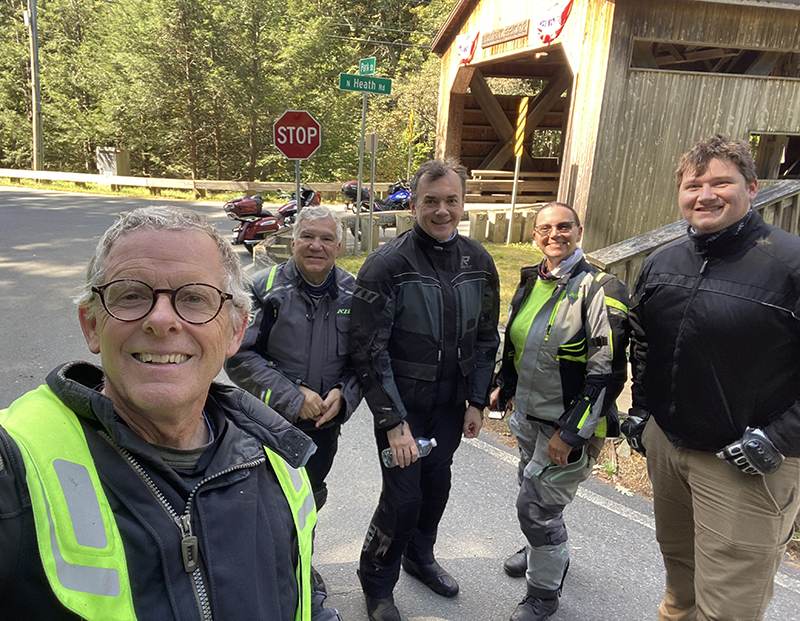
The Riding in the Zone street group stops for breaks at a few scenic areas, but no time is wasted. After taking photos at a covered bridge, Ken walks us through a hairpin turn 100 yards away. We discuss and walk the line in both directions including the entry point, apex, and exit.
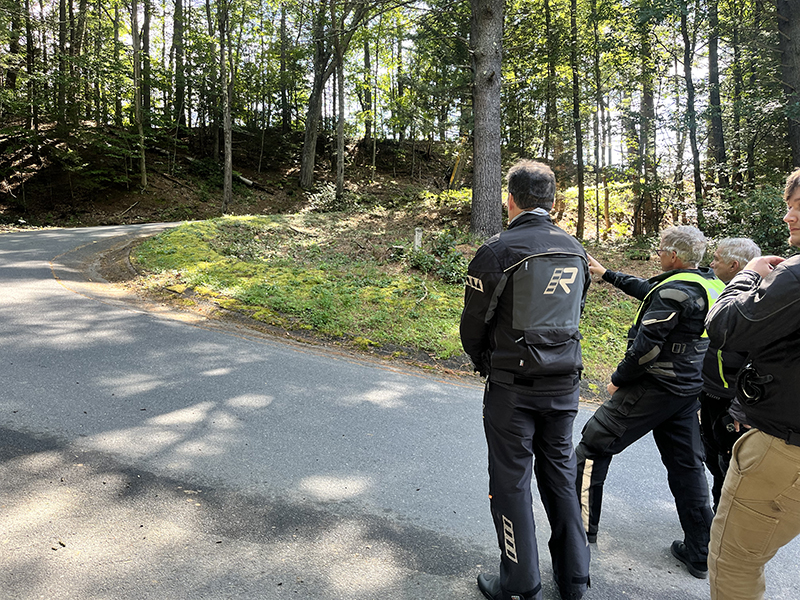
Grabbing lunch at the Village Roost, in Wilmington, Vermont, there’s plenty of time to chat, do a little shopping, and enjoy tasty sandwiches. This is the time to get to know each other and talk about motorcycles, gear, great rides, and everything else before heading out for more training.
The highlight of the day was the late afternoon climb to Mount Greylock near North Adams, Massachusetts. At 3,491 feet, the road to the highest point in the state offers great pavement, fantastic views, and lots of turns including hairpins. During this part of the ride Ken records each of us from behind, including the audio of his coaching tips and praises. Each student gets a link to the video, which is helpful for continued development long after the training day.
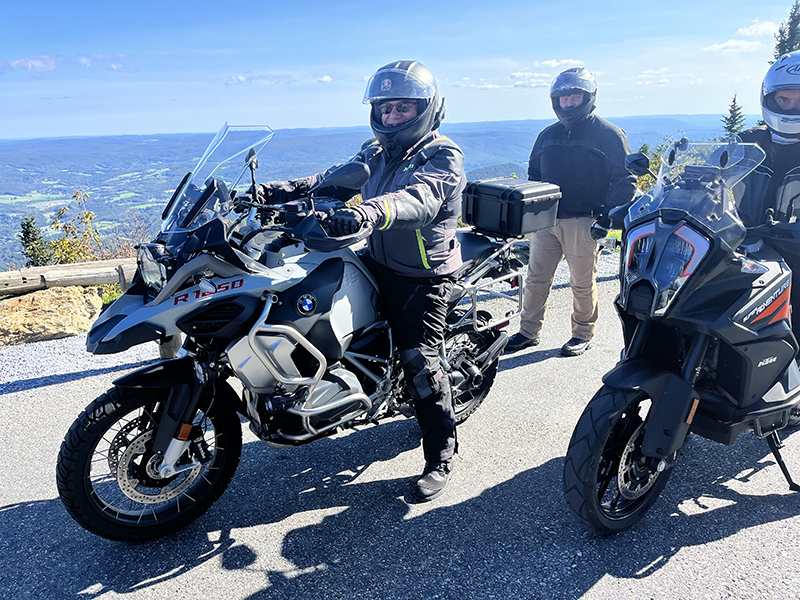

More Info
Ken’s Riding in the Zone offers everything from track day training to parking lot practices and private one-on-one sessions on the street and off-road. Visit RidingInTheZone.com to read Ken’s articles and to sign up for a class.
